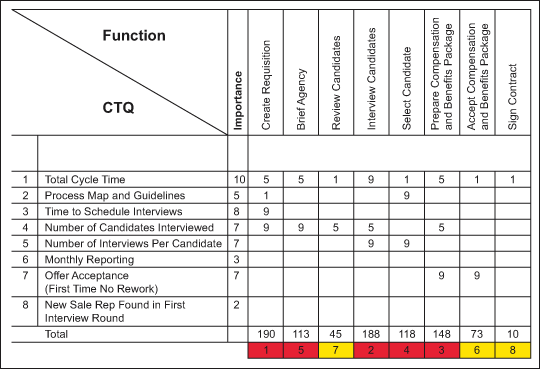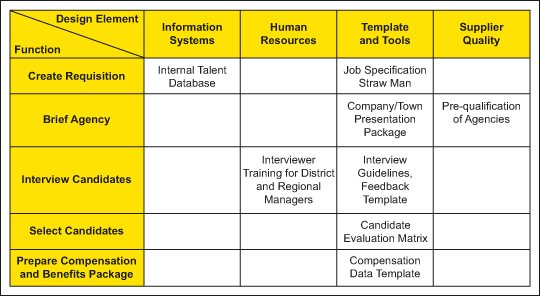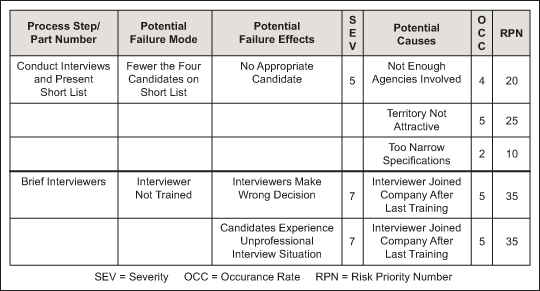
The following case study illustrates how a pharmaceutical company applied selected DFSS (Design for Six Sigma) tools to develop a new recruiting process for sales representatives. Tools and activities are described along the IDOV (Identify, Design, Optimize, Verify) phases, which served as a guiding roadmap through this process design project.
Identify
The need to completely redesign the recruiting process resulted from two weakness in the existing process. First, with an average of 60 days to fill a vacant sales representative position, it simply took too long. Second, due to a growing market in the upcoming three years, an increase of the sales force by 10 percent was planned, and the company wanted to organize its hiring process to make it as effective and efficient as possible.
Every day without a sales rep in a specific region meant a significant loss of revenue. Therefore, all vacant positions in Europe were in scope of the project. The process cycle time was measured from the point of time when the previous sales rep quit the job until the first working day of the new sales rep.
Under the project lead of a human resources (HR) associate, a team with representatives from sales and HR was established. Additionally, a steering committee with members from the same departments and from IT and Controlling was set up. They would meet at the end of each IDOV phase to review the project progress and to make go or no-go decisions for the next phase.
As one of the first steps, the team conducted a voice of the customer (VOC) data collection. Twenty district managers and four HR representatives who had all been involved in at least one recruiting process in the past were interviewed. The main questions to determine the customer needs, their relative importance and measurable CTQs (critical to quality) were:
- Which aspects of the recruiting process are important to you?
- On a scale from 1 – 5, how important are these aspects for you?
- How would you measure that the process is performing according to your needs, and how would you know that your expectations are not met?
The results from this internal VOC were structured via quality function deployment (QFD), as shown in QFD 1 in Figure 1. This showed that in addition to the recruiting cycle time, the most important CTQs were:
- How often the new employee could already be selected during the first interview round (i.e., no need to run a second round of interviews)
- How long it takes to establish the interview schedule
- How often the new employee agreed to the initially offered compensations and benefits (i.e., no re-negotiation of the contract)

The most important CTQs were summarized in a design scorecard (Figure 2). Using historically collected data, a first baseline could be established that showed the performance of the customer requirements at the project start. This baseline information was also used to set the project goals.

Design
At the beginning of the Design phase, the team conducted a functional analysis. In a process design, functions are the high-level process steps. Developing functions enabled the team to define the necessary steps of the recruiting process without immediately having to think about solutions, detailed concepts or a detailed process design.
The team used a function tree (Figure 3) to analyze the process steps. This allowed for a definition of the process on levels 1 and 2.

In order to determine those functions that would contribute most to meet the customer requirements, the team used the QFD 2 (Figure 4). This highlighted that the next step, the detailed process development, should mainly focus on these process steps:
- Create requisition
- Interview candidates
- Prepare compensation and benefits package

Optimize
The Optimize phase started with the detailed process design. Using a deployment flow chart, detailed process steps, roles and responsibilities for the previously prioritized level 2 processes were defined. Figure 5 shows the process for planning and conducting the candidate interviews as an example.
Further detailed process design elements were:
- Conduct an agency briefing meeting with HR, the hiring district manager and an external agency
- Standardize the number of interviewers and interviewees
- Parellelize the processes, interview candidates and prepare the contract

Furthermore, detailed design elements in the categories of information systems, human resources and templates and tools, as well as supplier quality were developed for the same five prioritized processes steps. Figure 6 shows these design elements per process step. Among others, the team decided to establish an internal talent data base, to develop and conduct mandatory interviewer trainings, to create specific templates and guidelines for interviews, and to collaborate only with pre-qualified agencies.

As a last step in the Optimize phase, a risk analysis for the new process was conducted using the failure mode and effects analysis (FMEA) approach. The objective was to identify potential failure modes and their potential causes upfront so that appropriate mitigation actions could be determined. An extract of this FMEA is shown in Figure 7.

Verify
The DFSS team piloted the implementation of the new recruiting process in three regions and collected new data for the CTQs. They also gathered and analyzed information with regard to the highest prioritized failure modes from the FMEA. In doing this, they wanted to validate what the critical process steps were that had to be controlled as leading indicators of the desired (lagging) process performance.
Based on the pilot experiences, the team made final modifications of the process. Among others, they decided to have the contract already prepared before the second interview date (even if that meant that up to three contracts had to be created in case three candidates were still left). All critical process steps, leading and lagging indicators, and a reaction plan were summarized in a process management chart (Figure 8).

After this successful completion of the pilot phase, the team handed the new process over to the process owner, in this case the head of HR. She was responsible for the implementation of the process in Europe. Six months later the first results of the implementation could be measured, and they fully met the expectations of all stakeholders.